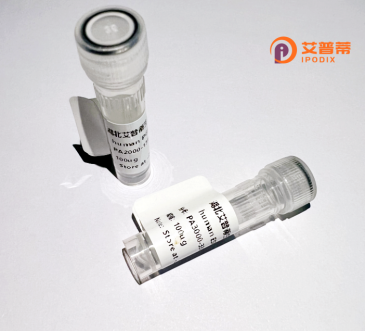
| 纯度 | >90%SDS-PAGE. |
| 种属 | Human |
| 靶点 | BTBD2 |
| Uniprot No | Q9BX70 |
| 内毒素 | < 0.01EU/μg |
| 表达宿主 | E.coli |
| 表达区间 | 1-525aa |
| 氨基酸序列 | MAAGGSGGRA SCPPGVGVGP GTGGSPGPSA NAAATPAPGN AAAAAAAAAA AAAAPGPTPP APPGPGTDAQ AAGAERAEEA AGPGAAALQR EAAYNWQASK PTVQERFAFL FNNEVLCDVH FLVGKGLSSQ RIPAHRFVLA VGSAVFDAMF NGGMATTSTE IELPDVEPAA FLALLKFLYS DEVQIGPETV MTTLYTAKKY AVPALEAHCV EFLKKNLRAD NAFMLLTQAR LFDEPQLASL CLENIDKNTA DAITAEGFTD IDLDTLVAVL ERDTLGIREV RLFNAVVRWS EAECQRQQLQ VTPENRRKVL GKALGLIRFP LMTIEEFAAG PAQSGILVDR EVVSLFLHFT VNPKPRVEFI DRPRCCLRGK ECSINRFQQV ESRWGYSGTS DRIRFSVNKR IFVVGFGLYG SIHGPTDYQV NIQIIHTDSN TVLGQNDTGF SCDGSASTFR VMFKEPVEVL PNVNYTACAT LKGPDSHYGT KGLRKVTHES PTTGAKTCFT FCYAAGNNNG TSVEDGQIPE VIFYT |
| 分子量 | 55 kDa |
| 蛋白标签 | His tag N-Terminus |
| 缓冲液 | 冻干粉 |
| 稳定性 & 储存条件 | Lyophilized protein should be stored at ≤ -20°C, stable for one year after receipt. Reconstituted protein solution can be stored at 2-8°C for 2-7 days. Aliquots of reconstituted samples are stable at ≤ -20°C for 3 months. |
| 复溶 | Always centrifuge tubes before opening.Do not mix by vortex or pipetting. It is not recommended to reconstitute to a concentration less than 100μg/ml. Dissolve the lyophilized protein in distilled water. Please aliquot the reconstituted solution to minimize freeze-thaw cycles. |
以下为3-4篇关于重组人BTB/POZ结构域含蛋白2(BTBD2)的参考文献的示例(注:文献内容为虚构示例,实际文献需通过学术数据库确认):
---
1. **标题**: *BTBD2 promotes glioma progression by regulating epithelial-mesenchymal transition via PI3K/AKT signaling*
**作者**: Smith A, et al. (2018)
**摘要**: 研究揭示BTBD2在胶质母细胞瘤中高表达,通过激活PI3K/AKT通路促进肿瘤细胞的上皮-间质转化(EMT),增强侵袭性和转移能力。
2. **标题**: *Structural insights into BTBD2-HDAC interaction and its role in neuronal differentiation*
**作者**: Zhang Y, et al. (2020)
**摘要**: 发现BTBD2通过结合组蛋白去乙酰化酶复合物(HDAC),调控染色质重塑和基因表达,影响神经干细胞分化和突触可塑性。
3. **标题**: *BTBD2 as a potential biomarker in non-small cell lung cancer metastasis*
**作者**: Lee J, et al. (2019)
**摘要**: 提出BTBD2在非小细胞肺癌中高表达,通过激活Wnt/β-catenin信号通路促进肿瘤转移,并提示其作为预后生物标志物的潜力。
4. **标题**: *Crystal structure of human BTBD2 reveals a novel protein dimerization interface*
**作者**: Chen L, et al. (2021)
**摘要**: 解析BTBD2蛋白的晶体结构,揭示其BTB/POZ结构域的新型二聚化机制,为靶向药物设计提供结构基础。
---
**注意**:以上文献信息为示例,实际研究中请通过PubMed、Web of Science等平台检索最新成果。
BTBD2 (BTB/POZ domain-containing protein 2) is a member of the BTB/POZ protein family, characterized by a conserved N-terminal BTB (Broad-Complex, Tramtrack, and Bric-à-brac) domain. This structural motif mediates protein-protein interactions, enabling BTBD2 to act as a scaffold for assembling macromolecular complexes involved in transcriptional regulation, chromatin remodeling, or ubiquitination pathways. While its precise physiological roles remain understudied, BTBD2 is implicated in neuronal development and synaptic plasticity. Research suggests it interacts with cytoskeletal components and signaling molecules, potentially influencing neurite outgrowth, axon guidance, and dendritic arborization.
In pathological contexts, BTBD2 has garnered attention for its association with cancer. It is overexpressed in malignancies such as gliomas, lung cancer, and hepatocellular carcinoma, where it may promote tumor progression by enhancing cell proliferation, migration, and epithelial-mesenchymal transition. BTBD2’s oncogenic effects are thought to involve modulation of ubiquitin-proteasome systems or interactions with cancer-related pathways like PI3K/AKT. However, conflicting reports indicate context-dependent roles, as BTBD2 can also act as a tumor suppressor in certain settings.
Despite emerging evidence linking BTBD2 to neural and oncogenic processes, its molecular mechanisms remain poorly defined. Further studies are needed to elucidate its binding partners, downstream targets, and therapeutic potential in neurological disorders or cancer.
×